Within the same week in September 1899, five new football grounds staged their first match. Highfield Road in Coventry, Tottenham’s White Hart Lane, Sheffield Wednesday’s Hillsborough, Fratton Park in Portsmouth, and Grimsby Town’s Blundell Park.
Having attended matches at the first four grounds – of which Highfield Road and White Hart Lane now have been demolished, and the future of Fratton Park is in the balance – I am looking forward to completing the set with a visit to Blundell Park. But most of all, I am looking forward to taking my seat in the oldest main stand in the English league.
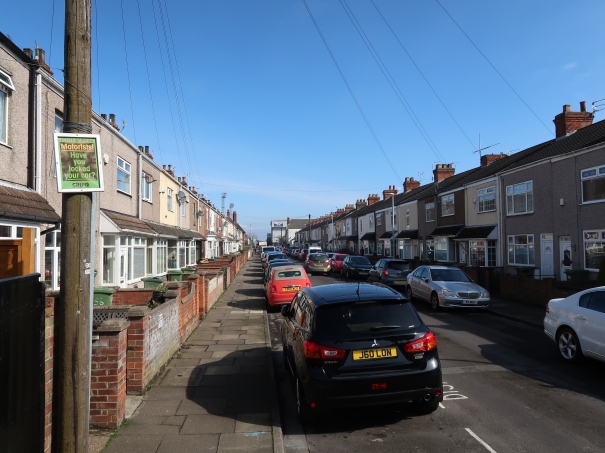
Although it is often pointed out that Grimsby Town actually play in Cleethorpes, whereas Cleethorpes play in Grimsby, we decide to take the train to Grimsby Town and walk to the ground. After all, this is a chance to get an impression of Grimsby. According to Wikipedia, legend has it that it was founded by a Danish fisherman. That is not the reason, however, why I have been looking for Grimsby Town’s results over the years. When I started at university in Copenhagen 1982, football fans were few and far between. I finally managed to find one – and his favourite team was Grimsby! They had recently won promotion to the second tier of English football – and he thought it was cool of seaport town to challenge the clubs in the big industrial cities. So I started looking for Grimsby’s results.

The forty minute walk from the station takes us through street after street of terraced housing. They look very much alike, so it is oddities like seeing two neighbours placing a christmas tree and a palm tree respectively in their tiny front garden that springs out. And the sun! I have been warned that it will be freezing cold with stadium almost next to the North Sea, but we seem to have been blessed with the first real day of spring – sunshine and 7 or 8 degrees.
I had written to the club in advance and asked about the possibility of taking some photos of the ground before the match for my blog. And stadium manager Nick Dale has very generously agreed to take me and my son Thomas on a tour round the ground in the morning before the match against Stevenage. As we have tickets for the old main stand, this is the opportunity to take a photo of it from the opposite side of the field.

Acccording to football ground expert Simon Inglis, Grimsby Town played in Clee Park when the club was formed in 1878, but in 1889 moved to Abbey Park. In 1899, however, the owner of Abbey Park sold the ground for housing, so Grimsby Town moved back to Clee Park and opened Blundell Park in September, bringing two stands from Abbey Park with them. But when they two years later won promotion to the first division, 150 fans pledged to give £10 each to build a proper main stand. And that is the stand that is still there. Amazing! 117 years old, it is the oldest surviving stadium structure in a British football ground.
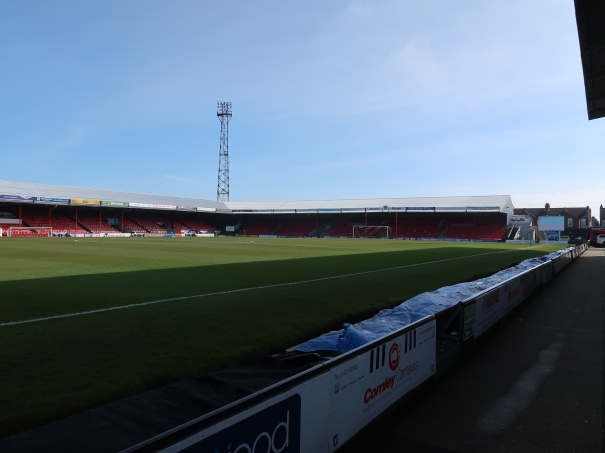 The stand originally only covered about half the length of the pitch, and as Grimsby dropped out of the league, it seemed that it would stay like that. But a second spell in the first division from 1929 generated money to extend it in 1931 towards the corner flag by the end by Neville Street. Here, one of the wooden stands from Abbey Park was standing, until it was replaced by the current Osmond Stand in 1939 – the money this time generated from Grimsby Town’s appearance in the FA Cup semi-final against Wolves at Old Trafford. Amazingly, the crowd of 76,962 remains the highest ever at Old Trafford!
The stand originally only covered about half the length of the pitch, and as Grimsby dropped out of the league, it seemed that it would stay like that. But a second spell in the first division from 1929 generated money to extend it in 1931 towards the corner flag by the end by Neville Street. Here, one of the wooden stands from Abbey Park was standing, until it was replaced by the current Osmond Stand in 1939 – the money this time generated from Grimsby Town’s appearance in the FA Cup semi-final against Wolves at Old Trafford. Amazingly, the crowd of 76,962 remains the highest ever at Old Trafford!
Seen from the opposite side of the pitch, the L-shape of the Main Stand and Osmond Stand may look a bit odd, but it is exactly this fact that gives the ground character compared to modern grounds. Some of the highlights of the club’s history are inscribed or perhaps rather embodied in the stands. The ground doesn’t look like this because some random architect thought it should. It looks like this because of two promotions to the top flight and a record-breaking FACup semi-final appearance.

The floodlight pylons tell a similar story. Standing 128 feet high on concrete bases, these pylons actually lit up the first floodlit match at Wolverhampton’s Molineux in 1953. Allegedly a 6-year-old George Best attended the match and later said: “it was the floodlights which made football magical for me, it turned football into a theatre”. In 1958, Wolves replaced the pylons, and Grimsby purchased them second hand. Nick tells us that none of his staff feels like climbing them to replace the bulbs, so he has to do it himself. It looks scary, and Nick assures us that it feels even more so, as the pylons sway in the wind that is constantly coming in from the sea.

As we walk along the Pontoon Stand behind the goal, we notice the considerable slope of the pitch in the goalmouth. It is difficult to catch on a photo, but if an attacking player is clean through in play, he would be ill advised to just trying to roll the ball into the net – it might stop on the way and roll back out in open play. In fact, later during the match, the Stevenage keeper looses his footing three or four times in the first half as he attempts to kick the ball upfield. Maybe because of the slope.

The slope is there for drainage of the goalmouth. And Nick tells us that the pitch at Blundell Park is actually the original one – one of only five pitches from the Victorian Era. It has never been relaid. No modern mixture of natural and artificial grass, no undersoil heating and drainage systems. Still, the pitch looks perfect – the sloping apparently works. And Nick points out that they hardly ever have cancel a match.

We get to the main stand – which is made of timber. As I understand Nick, it has always been an all-seater stand, but since writing that several Town fans have pointed out that they used to stand in the paddock at the front – right up till the 1980’s. Of course, the Bradford City fire in 1985 has taken the romantic gloss away from wooden stands, but I must admit that I am very fond of them. The soundscape during a match seems very different to modern, hard, concrete floors. When it is quiet in the stands, there is strange indoor-living-room-feel; but when something happens to get the crowd on their feet, you hear it and feel it.
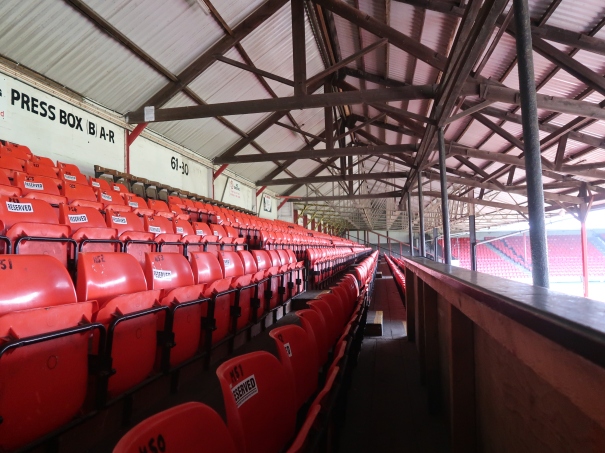
Even the roof construction is made of timber – the Archibald Leitch stands I have visited have all had distinctive steel constructions. And steel was also used for the extension of the stand in 1931, as you can see on the photo above.

Some people make a great fuzz about pillars in old stands restricting the view. And, admittedly, in some cases I have had my view severely restricted. But these ones are so fine and narrow that they just make you have to move with the flow of the game. Of course, if you are not prepared to move an inch, you may miss a glimpse of the action. But going to a match, you are there to take part in the flow of the game. To go back to the George Best quote on floodlights turning football into theatre, wooden stands and pillars have a bit of the same effect.
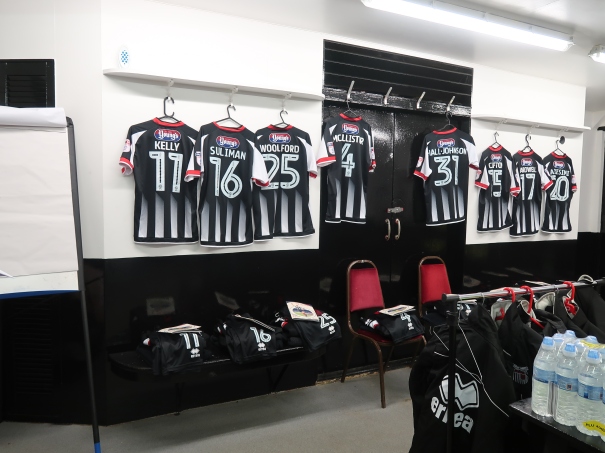
Nick takes us to have a quick look into the dressing room – with about three hours to kick-off, everything is ready for the players’ arrival.
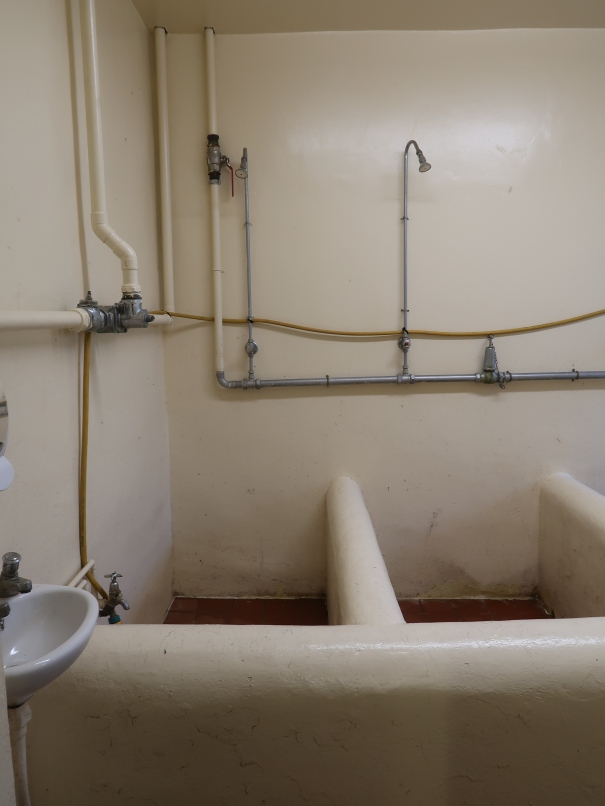
The old bath tubs are still there, although they are no longer in use. The players have to make do with a shower nowadays. The players would probably prefer a top-modern dressing room – but hopefully the bath-tubs serve as an indirect reminder that Grimsby Town has been playing here for the locals for more than 100 year – and the players are here for a short time to carry on the torch for the fans.

Next stop is the match officials’ facilities. Sandwiches are ready for them, a there is a kettle for them to make some tea. And an old television. Nothing luxurious about this either. But then I remember visiting the similar room at the Etihad. That one seemed almost just as barren – but was in much starker contrast to the players’ dressing room.

With me and my son both being 6 foot 5, we cannot help noticing that footballers as well as supporters were much smaller when the stand was built 117 years ago: “Mind your head” warnings are really a must here.
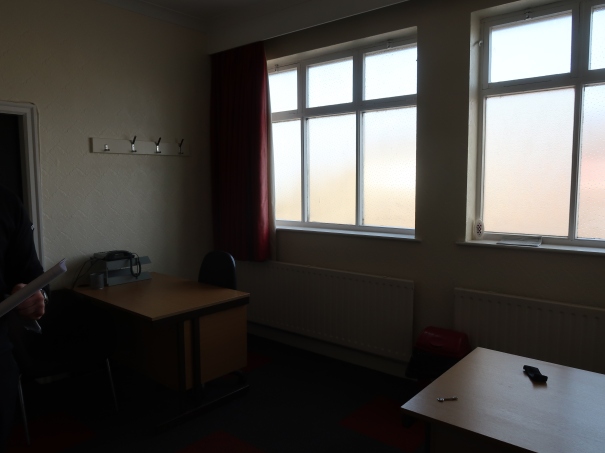
Moving to the top floor, we get a look inside the manager’s office. It looks as though somebody has just cleared it – and, in fact, it is only a few weeks since Michael Jolly took over as manager at the club. Apparently he has spent all time on the training ground until now.
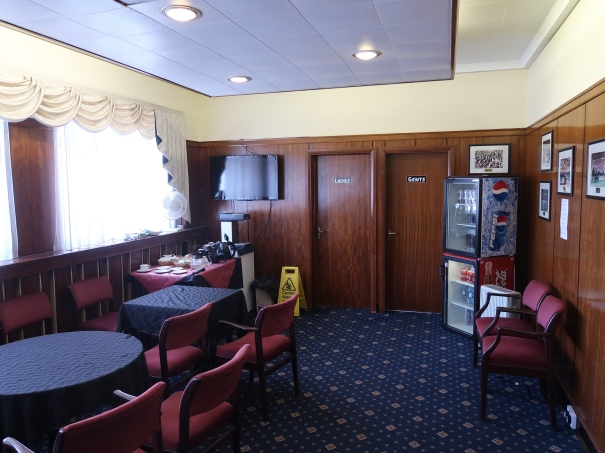
Opposite the manager’s office is the old board room. It is not used by the board anylonger, but it is used for guests on matchdays. Looking at the panels, you cannot help thinking of the pride the 150 supporters, who raised the money for this stand, must have felt back in 1901.
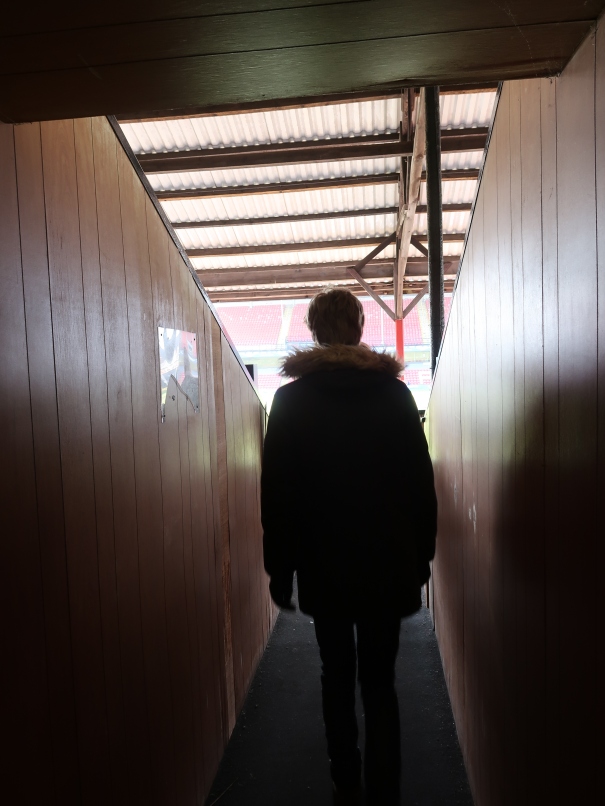
The same panels mark the entrance to the old directors’ box. Whereas the old wooden seats have been replaced by red plastic seats in the rest of the stand, there are still wooden seats in the box. Apparently different sponsors have led to the mix of colors. I look at the seats with a bit of envy. Not just because it feels more authentic than plastic; there seems to be much more space for the legs here.

Down the stairs, we take the walk through the players’ tunnel to pitch side.
Opposite us, the two-tier Findus stand towers over approximately half the length of the pitch, very much like the Main Stand used to do until the extension in 1931. It was built in 1980 by fish processing firm Findus – again at a time when Grimsby’s footballing fortunes were on the rise. Even though cantilever stands were quite common by then, the roof is still supported by pillars. The roof only covers the upper tier (from where you supposedly can see the ships sailing by behind the main stand). The lower tier has probably been a standing paddock – in the open. In the middle of the stand, there is row of corporate boxes.
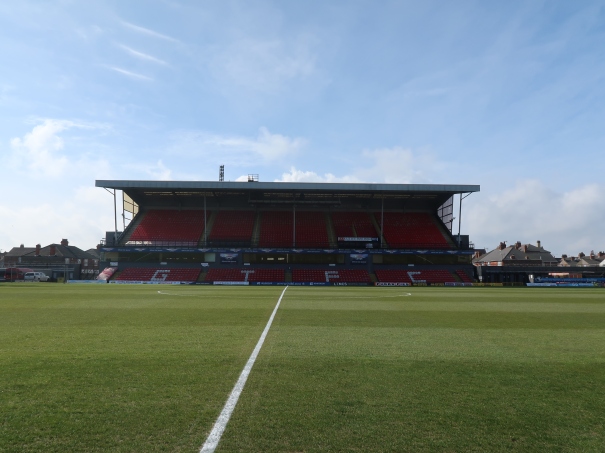
That is where we head next. The boxes cater for some 150 guests on match days. All of them being served in the same lounge.

From the boxes, you can clearly identify the 1901-part of the main stand opposite through the red pillars. It is strange that they didn’t extent it to the other side in 1939 when Grimsby earned the FACup money, but opted for the Osmond Stand instead. Maybe the old wooden stand there was is such a bad state that it had to be replaced then. Maybe an extension of the main stand was planned, but the outbreak of the World War and the ensuing slumb in Grimsby’s fortunes put them to a halt? One day, I will have to look closer into the history of that.
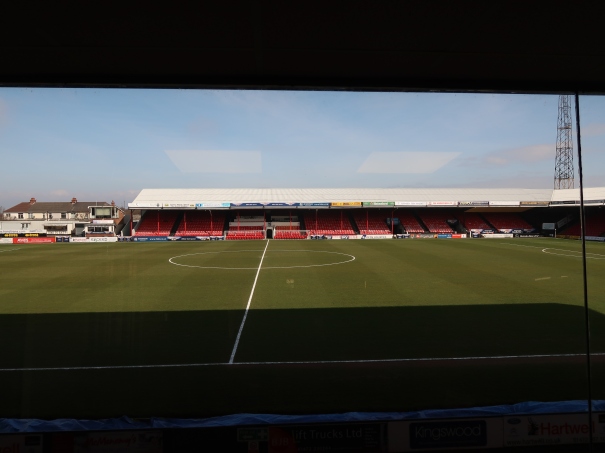
Having said hello to Grimsby Town commercial manager and former star player David Smith (who tells us that he actually played Denmark in an U-21 match for England in the 1980’s), Nick takes us to the new board room – awaiting the directors’ of both the clubs before today’s game. And I ask him if it is really true that the Grimsby directors still present the visiting directors with a package of fresh fish. Alas, it is not. They stopped back in the 1980’s or early 1990’s. 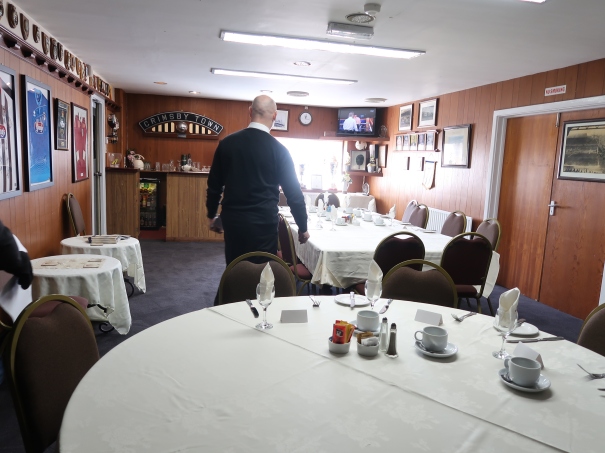
Finally, Nick takes us to the supporters’ bar in the Findus stand – or Young’s stand as it is called at the moment. We have a pie and a drink – and gradually the bar fills with supporters. The mood is not very good. Grimsby hasn’t won since early December and is staring potential relegation to the National League in the eyes. It is only two years since Grimsby managed to get out of the National League after 7 years. The guy next to us has been following the fortunes of his side for more than sixty years. And he will be here next season, no matter what happens. And, he points out, when they were in the National League, they stood out by their massive, loyal away support. Although he didn’t travel to away matches himself – instead he went to see local rivals Scunthorpe, hoping they would lose. In fact, Scunthorpe are on TV against Oxford – and are really playing Oxford off the park.

Apart from the plight of the team, the supporters are also quite disturbed by the beer being served in plastic glasses. They used to serve it in proper glasses here, but for the last home match against Port Vale, some Grimsby yobs had got into the bar. And as some Port Vale fans had managed to make their way, there had been a small scuffle and glasses had been thrown. First bit of trouble for years, but now the door through which the Port Vale fans had entered had been blocked – and the glass had been replaced by plastic.

As we are in fishermen’s town, we have to have a fish ‘n chips before the match. So rather than waiting for kick-off, we leave the bar 1½ before kick-off to find a chippy. As we get out, the weather has changed dramatically. From bright sunshine and blue sky to a cold mist blowing in from the sea. The floodlight pylon on the other side of the pitch is difficult to see.

I have started to register facilities at football grounds that probably wouldn’t have been there 30 or 40 years ago. Or seem unusual. Blundell Park is only the second English stadium I visit with official bicycle parking – although they stress that it is at the owner’s risk!
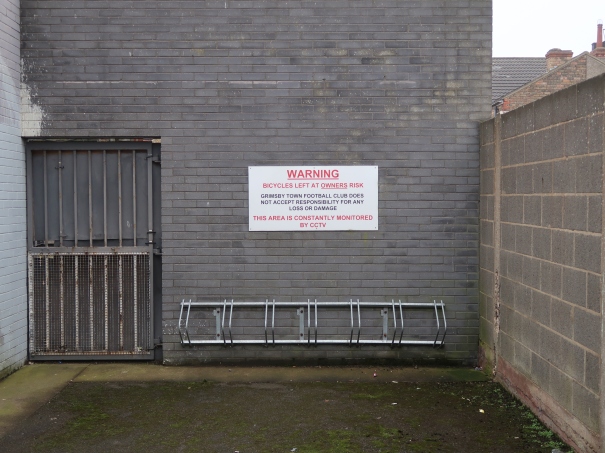
Finding a chippy turns out to be easy. The Mariners is just around the corner. I think it is quite good – but my son thinks that the ones we usually get at Lou Macari’s before matches at Old Trafford beat it.
After the chippy we walk around the ground towards the official entrance to the Main Stand. There is nothing like a football ground tucked away behind terraced housing. It is as though it has grown out of its local community. The floodlight pylons rising about. And the little glimpses of the stand in the back garden of the houses.
Apart from the two roads leading to the front of the Findus Stand, you can only enter the ground from two alleys from Harrington Street, separated from the coast only by a railroad track. The first alley leads to the visitors’ entrance in the Osmond Stand. The timber facade of the main stand is stunning – just as it is amazing to look into the back gardens of the neighbouring houses immediately behind it.
We continue down the road towards the main stand entrance for home fans. Again – it is really thrilling to catch glimpses of floodlight pylons and the stand between the houses on the street.
Entering the ground, we get a closer look at the wood. We can see the downside to it – it is really a maintenance challenge. But worth it. In most businesses you would like to have a unique brand, setting you apart from competitors. If Grimsby build a modern concrete stadium outside the town – and especially if they drop into the National League – who will go? If they line going back 117 years is broken, how many fans will decide that if they have to go by car to the new ground, why not go all the way to league match in Scunthorpe or Hull?
We find our seats in the stand – perfect! With restricted view – which at no point bothers us. If we were to complain, our knees are hurting because lack of leg space – long before halftime. But that only adds to the sense of being there.
Supporters for the Pontoon Stand enter the ground through turnstiles next to the Findus stand. You can see the housing behind the turnstiles. In many ways, the magic of a football ground is creating a theater, cut off from the exterior world. Two days after this match, we go to the Academy Stadium by the Etihad, where we can hear the heavy traffic just outside the stand. Which ruins the theater-like feeling. Blundell Park is not a closed bowl either. But houses look like a piece of scenography intended to make you feel that you are in Grimsby (or Cleethorpes, as the locals will stress). There is nothing disturbing the atmosphere.

From our seats in the Main Stand, the slope in the goal mouths is clearly visible. It looks as though the club photographer has also spotted it!

Just before the two teams enter, the floodlights are turned on. We look anxiuously as it seems that one of the bulbs need changing – poor Nick. We are glad we don’t have to do the climb. As I spot a female linesman, I think of the match officials small room. I had thought that it was small for four men. Could there have been separate changing facilities for female match officials in there? Come to think of it, I didn’t get to see if there was more than one shower. Incidentally, she is on duty again three days later, when we are at Oldham.

As we are seated right behind the benches, it gives a good opportunity to study the contrasting styles of the two managers. Stevenage’s Tunisian manager Dino Maamria is a tracksuit manager. He runs to the 112 away supporters before the match and greets them. He is constantly talking to his players, high-fiving them, padding them on the back.
New Grimsby manager Michael Jolley is wearing a smart suit – although he doesn’t look that comfortable in it. He greets the home crowd for his second home match in charge – but seems to cut a lonely figure, standing on the touchline. He is not talking very much, but his frustrations as Grimsby miss a couple of decent chances are clear to see. Just before halftime he finally communicates with an assistant – to get a coat.
As for the match, Grimsby desperately need the points. And gradually they built up some momentum to create a few good chances. But when you haven’t won for 18 matches, confidence runs low and chances are wasted.
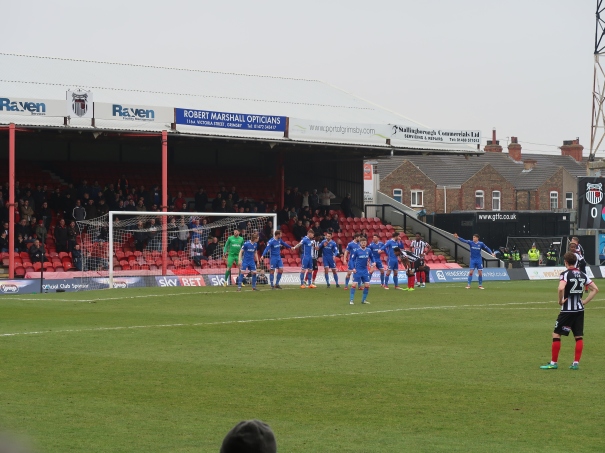
0-0 at halftime, and I take the opportunity to have a closer look at some of the stadium features. Such as the intersection of the 1901 stand with timber roof construction and the 1931 stand with steel construction.

The corner linking the Osmond Stand and the Main Stand turns out to be a peculiar no mans land. It probably used to be a standing paddock – but it has not been converted to seats and has therefore been fenced off. The number of seats you can put in there are probably not worth the investment.
The construction of the Osmond Stand is also a bit odd. I wonder if it is two drains right behind the goals – and if so, why they have been placed there? They certainly don’t seem to support anything.

I head for the gents’ room behind the main stand. Again, I love the feel of it being anything but mainstream, although I realize that during the winter months, you would love to be able to get inside for a bit of warmth during half time – and to have shelter when you are queuing for the toilets.
The second half gets under way – and now Maamria has also given in to the cold mist and put on a coat.
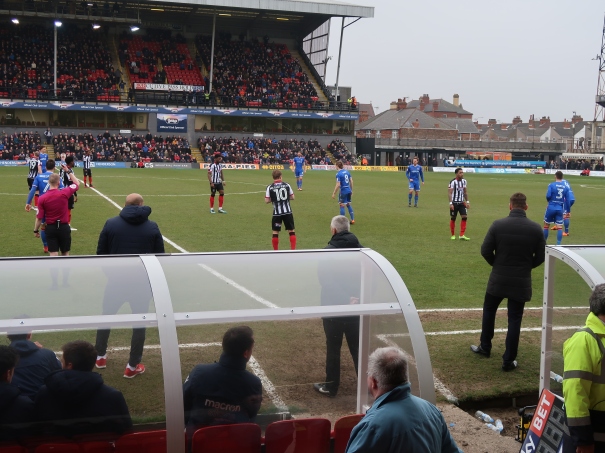
The match gets more and more tense – and Stevenage have a couple of good chances as well. It may not be football for the purists but it is entertaining – and the crowd of 5,368 create a good atmosphere. There is a small group of Grimsby supporters with a drum. But at least it is not constant banging – so it is not that distracting.
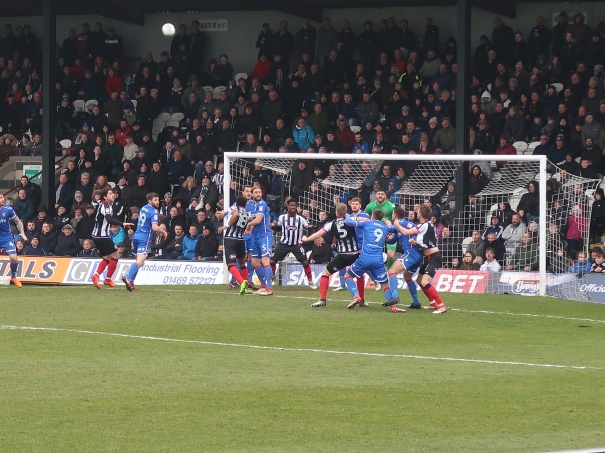
Opposite in the Findus Stand, a few people get up to leave before the final whistle. But quite a few of them regret -and watch the last few minutes standing, hoping for a late winner. It doesn’t arrive. The match ends in a goalless draw. Frustrating – and the fans seem resigned.

As we leave the ground, we walk past the Grimsby substitutes’ bench. With the 119 year old Victorian pitch next to it, I come to think of it as an archaeological excavation site. What has been left from that bench over decades? If Grimsby leave the ground, will they allow archaeologists to dig and explore what players have been eating/drinking/smoking over the years?

As we exit the ground, I look for a sign telling that this is a residential area, asking fans to leave quietly. There are signs like that at other grounds in residential areas. But I don’t spot it here.

Instead I notice two signs in the alley behind the parked cars. “Please do not park in front of these gates”. The alleys, however, seem to offer the best parking facilities in the small streets around the ground.

I had asked Nick about the plans for Grimsby Town to move to a new ground. Well, he answers. There has been talks over the past three decades. And they have located a potential site outside town. But they need to find the funding. The main arguments for moving are costs of maintenance and lack of parking facilities.
As I get back to Denmark and search for more information on the potential move, I find this passage in a report by the North East Lincolnshire Council:. Community Impact and Social Value Assessment.
“Blundell Park, the Club’s current home, was built in Victorian times and is now uneconomic, outdated, and not fit for modern-day football. GTFC is at risk of going out of business unless it follows the pattern of other clubs that have successfully achieved relocation and subsequent sustainability.”
You could also look at clubs who have obtained the opposite by building a new stadium. Darlington, for instance. Nine years after moving to their new stadium, the club was wound up in High Court. Clubs look at potential income from more fans, more hospitality facilities – and an overall increase in turnover from greater number of visitors. But if change is not followed by immediate success on the pitch, what happens then? What happens, if Grimsby is relegated? If fans are angry at not being able to drink their prematch beer from glasses before the match, will they follow a relegated team to see them play in a completely new stadium outside town – that carries nothing of the tradition and history of the club?
In the “Football Stadia and Grounds” facebook group, there are lots of fans complaining about their new ‘soulless’ grounds. You could argue that only a special segment of fans are members of such a group. And that the majority will enjoy the comforts of good parking facilities, unrestricted view, more leg-room in the stands (although it is not necessarily good even at new grounds), more catering- and hospitality facilities. But you could argue that if convenience is the main thing, then a new stadium won’t count for much, if you are relegated.
If they leave, the club will be selling 120 years of history. Of promotions and FA Cup semifinals in their heydays. Of the floodlight pylons that captivated George Best at Molineux. Of the Victorian pitch. Of the Findus stand from the time when Grimsby got up to the second tier of English football again. The stadium is a monument over the club’s history. Which must be dear to the heart of the club’s true supporters.
The verdict that it “was built in Victorian times and is now uneconomic, outdated, and not fit for modern-day football” sounds as though it has been made by businessmen or politicians with no sense of history – and no knowledge of the importance of ‘place’ for identity.



































Excellent article, the “drainpipes” in the Osmond stand are actually the supports for the old scoreboard.
Wonderful piece of writing!
brilliant read, the two drain pipe like poles behind the goal in the away end used to hold up the scoreboard (https://www.gettyimages.co.uk/detail/news-photo/the-scoreboard-shows-the-home-side-have-got-the-better-of-news-photo/651995738) this was taken down a few years ago for the new electronic board in between the Findus and away stand.
The main stand hasnt always been all seater.i used to stand in there at the front in the 70s.nick dale doesnt no much of our history
Great to read this insight from a stranger…. well done
What a shame you visited one of the worst fish and chip shops in grimsby,a 2 minute walk either way and you would of been in heaven
Which one should I visit next time?
To up to cleethorpes,commonly referred to as ‘ meggies’.Steel s is an institution.you won’t get better haddock and chips anywhere and if you loved the nostalgia of the surroundings at b.p. You will be similarly enamoured by the old fashioned nature of steels
Lovely article
Just eat them in the ground in McMenemys they are first class
An excellent piece of work. Tusind tak.
We have managed a goal or two since …
A superb article and photos, very well done.
Great reading an article from a neutral observer…. really good piece! Well done!
Blundell Park may be old and yes, it needs lots of maintenance, but it’s served me, my father, my grand-father and my son just fine over the past century or so
If we are still playing here in another 10 years or so maybe I’ll have a grand-son who can also share in our delight ( and our occasional sorrow )
#UTM
Enjoyed reading this , Grimsby on the whole has a colourful and varied history , but sadly mostly erased by poor unvisionary councils , Iam sure more blunders are on the horizon .
These types of grounds just don’t exist where I’m from. Great article, I love the heritage and cultural aspect of football.
Brilliant piece of writing really enjoyed it and it’s true what you said as for the new ground more chance of seeing pigs fly mate we’re sick of hearing about it.
Totally enjoyed reading your blog of my beloved GTFC. Hope you had a good day.
I loved it. And hope to be back soon!
Thanks for an interesting read. Ever since the early nineties I have been a staunch pro new stadium “activist”. I never gave a thought to the nostalgia and history of Blundell Park, only seeing it as an odd, embarrassing, decrepit ground, well past its sell by date. I wore my red Conoco stadium cap with pride in the early nineties, when the new ground at Great Coates was being proposed. For the last few years I have posted Emails, written on social media, written to the local newspaper and the local council in support of new stadia on Peaks Parkway. But all the while I had a gut feeling the out of town areas proposed, were not suitable and I secretly feared the soulless, half empty concrete dome so often evident in today’s game. People say you don’t miss something until you no longer have it. I feel this could be the case if we move. If and when a new stadium is built I hope it will be at the heart of our community, have character, meaning and be something the whole area can be proud of. Unfortunately, though, I have no confidence the current board can, or will deliver this.
Always a common misconception that The ground is on the North Sea actually on the banks of the River Humber